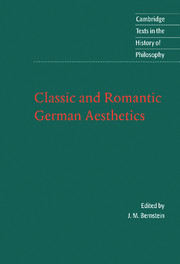Book contents
- Frontmatter
- Contents
- Introduction
- Chronology
- Further reading
- Note on the texts
- Aesthetica in nuce: A Rhapsody in Cabbalistic Prose (1762)
- Laocoön: An Essay on the Limits of Painting and Poetry (1766)
- From ‘On the Artistic Imitation of the Beautiful’ (1788)
- ‘Kallias or Concerning Beauty : Letters to Gottfried Körner’ (1793)
- ‘Oldest Programme for a System of German Idealism’ (1796)
- ‘Letter to Hegel, 26 January 1795’
- ‘Being Judgement Possibility’ (1795)
- ‘The Significance of Tragedy’ (1802)
- ‘Remarks on Oedipus’ (1803)
- From Miscellaneous Remarks (1797)
- ‘Monologue’
- ‘Dialogues’ (1798)
- ‘On Goethe’ (1798)
- ‘Studies in the Visual Arts’ (1799)
- From ‘Critical Fragments’ (1797)
- From ‘Athenaeum Fragments’ (1798)
- From ‘Ideas’ (1800)
- ‘On Goethe's Meister’ (1798)
- ‘Letter About the Novel’ (1799)
- ‘On Incomprehensibility’ (1800)
- Index
- Cambridge texts in the history of philosophy
‘On Goethe's Meister’ (1798)
Published online by Cambridge University Press: 05 June 2012
- Frontmatter
- Contents
- Introduction
- Chronology
- Further reading
- Note on the texts
- Aesthetica in nuce: A Rhapsody in Cabbalistic Prose (1762)
- Laocoön: An Essay on the Limits of Painting and Poetry (1766)
- From ‘On the Artistic Imitation of the Beautiful’ (1788)
- ‘Kallias or Concerning Beauty : Letters to Gottfried Körner’ (1793)
- ‘Oldest Programme for a System of German Idealism’ (1796)
- ‘Letter to Hegel, 26 January 1795’
- ‘Being Judgement Possibility’ (1795)
- ‘The Significance of Tragedy’ (1802)
- ‘Remarks on Oedipus’ (1803)
- From Miscellaneous Remarks (1797)
- ‘Monologue’
- ‘Dialogues’ (1798)
- ‘On Goethe’ (1798)
- ‘Studies in the Visual Arts’ (1799)
- From ‘Critical Fragments’ (1797)
- From ‘Athenaeum Fragments’ (1798)
- From ‘Ideas’ (1800)
- ‘On Goethe's Meister’ (1798)
- ‘Letter About the Novel’ (1799)
- ‘On Incomprehensibility’ (1800)
- Index
- Cambridge texts in the history of philosophy
Summary
With no presumption, no sound and fury, like the quiet unfolding of an aspiring spirit, like the new-created world rising gently from within, the lucid tale begins. There is nothing extraordinary about what happens or what is said in it; the figures who appear first of all are neither great nor marvellous: a shrewd old woman who always has an eye to her own advantage and supports the wealthier suitor; a girl who escapes the snare of this dangerous schemer in order to give herself passionately to her lover; a pure youth who devotes the sweet ardour of his first love to an actress. Moreover, it is all there right before our eyes, appealing and alluring. The outlines are light and general, but they are sharp, precise and sure. The smallest trait is meaningful, every touch a gentle hint; and everything is enhanced by clear and lively contrasts. There is nothing here to enflame the passions, nothing at the outset to make violent claims upon our sympathies. But of their own accord the sprightly tableaux remain fixed in a mind cheerfully disposed to quiet enjoyment, just as we might retain the strangely clear and ineradicable memory of a landscape of simple and modest charm, which for a moment appears new and unique, suffused in a rare and beautiful illumination, or tempered by a marvellous mood of our feelings. The feelings are gently touched by the cheerful story, sweetly stirred in many ways.
- Type
- Chapter
- Information
- Classic and Romantic German Aesthetics , pp. 269 - 286Publisher: Cambridge University PressPrint publication year: 2002

